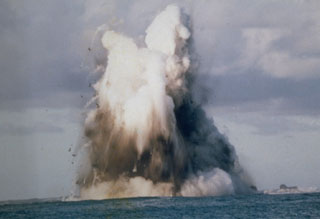Report on Nishinoshima (Japan) — 10 June-16 June 2020
Smithsonian Institution / US Geological Survey
Weekly Volcanic Activity Report, 10 June-16 June 2020
Managing Editor: Sally Sennert.
Please cite this report as:
Global Volcanism Program, 2020. Report on Nishinoshima (Japan) (Sennert, S, ed.). Weekly Volcanic Activity Report, 10 June-16 June 2020. Smithsonian Institution and US Geological Survey.
Nishinoshima
Japan
27.247°N, 140.874°E; summit elev. 100 m
All times are local (unless otherwise noted)
The Tokyo VAAC reported that ash plumes from Nishinoshima rose to 2.1-2.7 km (7,000-9,000 ft) a.s.l. and drifted NE and E. During an overflight on 15 June the Japan Coast Guard noted continuous activity from the central vent, including a gray-brown to black-brown ash plume rising as high as 2 km. Ejected material landed near the cone’s base. Lava from the NE side of the central vent flowed E. Steam plumes rose along the E coast where lava entered the sea, causing discolored brownish water offshore. The marine exclusion zone was defined as a radius of about 2.6 km from the island.
Geological Summary. The small island of Nishinoshima was enlarged when several new islands coalesced during an eruption in 1973-74. Multiple eruptions that began in 2013 completely covered the previous exposed surface and continued to enlarge the island. The island is the summit of a massive submarine volcano that has prominent peaks to the S, W, and NE. The summit of the southern cone rises to within 214 m of the ocean surface 9 km SSE.
Sources: Japan Coast Guard, Tokyo Volcanic Ash Advisory Center (VAAC)

